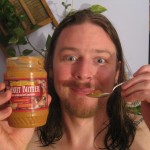 Among the wonders the Conquistadors discovered upon setting foot on the Americas was peanut butter. Well, it would have been more of a peanut paste—just roasted, mashed nuts—but the essentials were there in 1519 when Cortez and his lunatics showed up. Let’s assume the Aztecs had a long history with peanut butter because peanut butter is awesome and so are storied, long-dead ancient empires.
Among the wonders the Conquistadors discovered upon setting foot on the Americas was peanut butter. Well, it would have been more of a peanut paste—just roasted, mashed nuts—but the essentials were there in 1519 when Cortez and his lunatics showed up. Let’s assume the Aztecs had a long history with peanut butter because peanut butter is awesome and so are storied, long-dead ancient empires.
And now let’s jump to the 19th century. We’re jumping because even though peanuts spread around the globe after the colonization of the Americas and folks surely smashed and ate them, the public record rarely takes note of what Average Joe and Jane ate. It does take note, however, of issued patents.
In 1884, a Québécois named Marcellus Gilmore Edson received a patent for the process of milling roasted peanuts into a semi-fluid state between heated surfaces. When the goop cooled, it achieved, in Edson’s words, “a consistency like that of butter, lard, or ointment.” Yum.
Eleven years later, Dr. John Harvey Kellogg, the adorably zany proponent of curative morning cereals and laxatives, patented a “Process of Preparing Nut Meal.” Kellogg apparently thought that nuts would be the nutritional salvation of Earth’s rapidly expanding population, and his idea was to create a protein-rich food for folks who had lost all of their teeth. Rather than roast his peanuts before grinding, he steamed them. Yum.
The problem was, however, that peanut oil—like most (all?) vegetable oils—is naturally liquid at room temperature, and liquid nut oils tend to go rancid quickly. Refrigerated transport wasn’t an option, nor the common household fridge. Enter Joseph Louis Rosefield.
In 1922, Rosefield, a Californian and thus happily always on the cusp of the Next Big Thing, discovered that forcing hydrogen with a nickel catalyst into the oil of crushed peanuts at a very high pressure stiffens the fat molecules. Vegetable fats subjected to hydrogenation effectively replicate, chemically, animal fats that will stay solid or semi-liquid, as well as “fresh,” longer. Presto.
Rosefield licensed his process to Peter Pan the next year and in 1932 went into business for himself as Skippy Peanut Butter. I’m pretty sure Skippy did a honey roasted variety that my mother discovered in the early ‘90s and that I went to town on with a spoon. I still go to town on peanut butter with a spoon.
http://www.youtube.com/watch?v=VWDFVtWVJh4
Rosefield’s process created the mass market commercial peanut butters we know today. It also introduced to us, however, a version of peanut butter needlessly high in dangerous fat. The hydrogenation process turns the unsaturated fat of natural peanuts into saturated fat. Worse than natural saturated fats, the man-made saturated variety deforms the oil’s fatty acid chains with the pressure used to force the hydrogen atoms to bond to the fat molecules. This makes it harder for our bodies to break them down, and they end up hanging out in our bodies, lowering our “good” cholesterol, raising our “bad” cholesterol, and leading to all of those cardiovascular diseases we associate with too much saturated fat. To give you an idea, a Harvard study of margarine, which is made from hydrogenated oils, found it can increase a woman’s risk of heart disease by 70%.
Also, many major-label peanut butters these days incorporate partially hydrogenated oil, the stunted, semi-process brother of full-on hydrogenation. Partially hydrogenated oil is far, far worse for you than hydrogenated oil because in our bodies it turns into trans-fats, a completely artificial kind of fat that our bodies have no idea how to process. Rather than booting the trans-fats, our bodies think they kinda sorta maybe recognize them and so suck them into cell membranes as if they were regular, good fats, which are supposedto build those cell membranes. Trans-fats cause diabetes and coronary heart disease, and invert the positive effects breast feeding has proven to have on a child’s intelligence (What?!) Studies blamed trans-fats for about 100,000 deaths in America in 2006.
But I’m being a drag. I love the hell out of peanut butter. I routinely top scoopfuls of the natural variety—just peanuts and salt, no trans or saturated fats but a boatload of protein made complete by eating a slice of bread within 24 hours—with a drizzle of honey. I tend to follow the first spoonful with a second and a third and so on. I have to stir the oil back into the solids in the jar, but that’s no big deal. Badass Aztec warriors did the same. Probably in clay pots, though.
Thanks to The Kitchen Project, Whole Vegan, Live Strong, and the Kushi Institute for source info.




